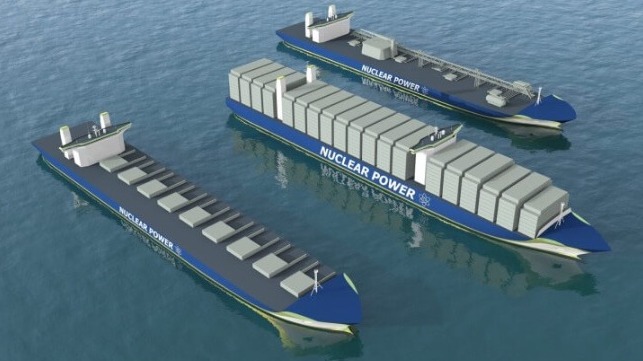Research: Large Commercial Ships Have Most Potential for Nuclear Power

As the maritime industry continues to search for solutions to meet the challenges of decarbonization and long-term financially practical applications, new interest is building in nuclear-powered propulsion for commercial shipping. Considered 75 years ago to be the future of the maritime industry, researchers are renewing exploration based on new technologies.
New research conducted at the Dutch technical university TU Delft for C-Job Naval Architects is the latest to conclude nuclear energy could be applied as marine propulsion in the future. According to the independent ship design company, nuclear technology has seen several interesting developments and should be considered for future maritime applications.
“Developments in nuclear energy have mostly been focused on land-based applications. However, a number of aspects make them of interest for maritime application. In particular, the significant reduction in harmful emissions,” concludes Koen Houtkoop, Msc. Marine Technology graduate at TU Delft who conducted the research. “There are obvious concerns with nuclear energy such as nuclear waste as well as societal perception. Additionally, we should be mindful that regulations for marine application are outdated and require significant effort for a successful application.”
The research identified large ocean-going vessels as having the most potential for nuclear propulsion. By creating four different concepts (bulk, container, tanker, and offshore), key items were analyzed, including the mass and volume of the energy storage and power generation system. It shows that, even though the shield around the reactor is a significant portion of the respective mass and volume of the nuclear power generation system, in most cases, the nuclear option is lighter and more compact than the conventional marine diesel option.
One of the key attractions driving the new interest in nuclear propulsion for commercial shipping is the solution for eliminating carbon emissions. Compared to conventional fuel-based systems, the research highlights that there can be up to a 98 percent reduction in CO2 emissions. Furthermore, the air pollution emissions, such as SOx, PM, and NOx, are eliminated.
While nuclear marine propulsion has a high capital expenditure, the research shows it to be cost-effective within five to fifteen years depending on fuel cost and the vessel’s operational profile. Furthermore, nuclear marine propulsion offers the potential to consider higher design speeds, making the ship more profitable. This is because fuel cost (OPEX) only grows marginally with higher speeds where ultimately the main limiting factor would be the CAPEX of the installation with more power.
Based on the research, C-Job, like others exploring the field, is drawn to the benefits of the Molten Salt Reactor. They concluded that it has the most potential in the long term for commercial shipping. The combination of passive safety, high burn-up, and the future potential to use the thorium cycle make it the best fit for maritime application said C-Job.
“Where maritime applications for ammonia, hydrogen, and methanol have advanced, nuclear energy so far has not been widely considered to be a viable option,” said Niels de Vries, Lead Naval Architect at C-Job. “As with other energy sources, appropriate safety measures must be in place and the technology must be developed further before it’s mature enough to be implemented but nuclear technology has serious potential.”
This research comes as others are also embarking on research into future applications of nuclear-powered propulsion. The U.S. Department of Energy, for example, has recently awarded new research projects to the American Bureau of Shipping to explore the commercial applications and hurdles and in a separate announcement today UK-based Core Power, the MIT Energy Initiative, and the Idaho National Laboratory will investigate the development of floating nuclear power plants off the coast of the United States.
Companies are already exploring the commercial potential for molten salt reactors. South Korea’s Samsung Heavy Industries, for example, formed a partnership with Seaborg, a Danish start-up pursuing next-generation nuclear technologies, and together they plan to develop floating nuclear power plant barges using Compact Molten Salt Reactor technology. Ulstein also recently released a concept for an exploration cruise ship using the same technology.
While the introduction of any form of nuclear-powered propulsion remains years away, the UK in 2021 sought input from the industry on nuclear power. While the responses said it was unlikely that nuclear-powered commercial ships would be in service before the end of the decade, they also said it was conceivable that the first of the vessels could be under construction by 2030.
The full research paper prepared at TU Delft for C-Job is available online.
